#Canadian Vickers
Text

1943 Consolidated PBV-1A Catalina "Miss Pickup" lifting off at the Imperial War Museum, Duxford
#Consolidated#PBY#PBV-1A#Catalina#Canso#Mop#flying boat#seaplane#Maritime patrol bomber#vintage aircraft#Boeing Canada (PB2B)#Canadian Vickers
78 notes
·
View notes
Text
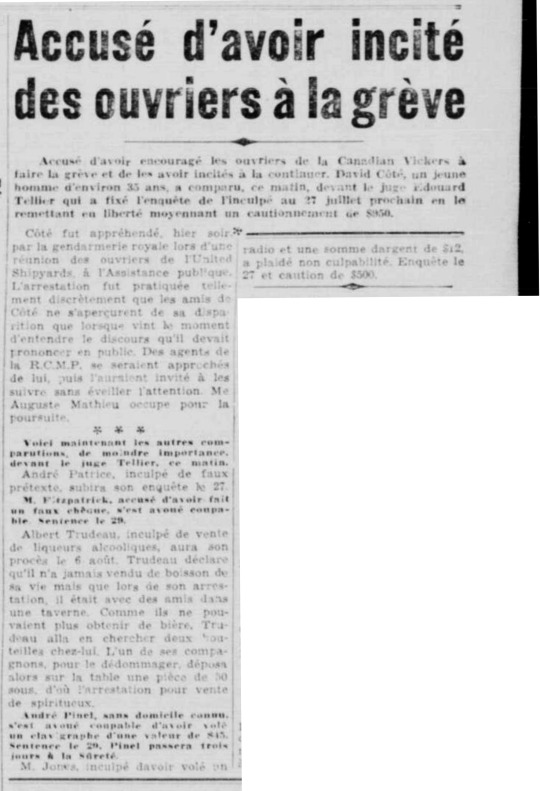
"Accusé d'avoir incité des ouvriers à la grève," La Patrie. July 25, 1943. Page 43.
---
Accusé d'avoir encouragé les ouvriers de la Canadian Vickers à faire la grève et de les avoir incités à la continuer. David Côté, un jeune homme d'environ 35 ans, a comparu, ce matin, devant le juge Edouard Tellier qui a fixé l'enquête de l'inculpé au 27 juillet prochain en le remettant en liberté moyennant un cautionnement de $950.
----
Côté fut appréhendé, hier soir par la gendarmerie royale lors d'une radio réunion des ouvriers de l'United Shipyards, à l'Assistance publique. L'arrestation fut pratiquée tellement discrètement que les amis de Côté ne s'aperçurent de sa disparition que lorsque vint le moment d'entendre le discours qu'il devait prononcer en public. Des agents de la R.C.M.P. se seraient approchés de lui, puis l'auraient invité à les suivre sans éveiller l'attention. Me Auguste Mathieu occupe pour la poursuite.
Voici maintenant les autres comparutions, de moindre importance. devant le juge Tellier, ce matin.
André Patrice, inculpé de faux prétexte, subira son enquête le 27.
M. Fitzpatrick, accusé d'avoir fait un faux chèque, s'est avoué coupable. Sentence le 29.
Albert Trudeau, inculpé de vente de liqueurs alcooliques, aura son procès le 6 août. Trudeau déclare qu'il n'a jamais vendu de boisson de sa vie mais que lors de son arrestation, il était avec des amis dans une taverne. Comme ils ne pouvaient plus obtenir de bière. Trudeau alla en chercher deux bouteilles chez-lui. L'un de ses compagnons, pour le dédommager, déposa alors sur la table une pièce de 30 sous, d'où l'arrestation pour vente de spiritueux.
André Pinel, sans domicile connu, s'est avoué coupable d'avoir volé un clavgraphe d'une valeur de $45. Sentence le 29. Pinel passera trois jours à la Sûreté.
M. Jones, inculpé d'avoir volé un et une somme d'argent de $12, a plaidé non culpabilité. Enquête le 27 et caution de $500.
#montreal#recorder's court#united shipyards#canadian vickers#political prisoner#union organizing#agitator#working class politics#suppression of dissent#working class struggle#false pretences#passing forged cheques#theft#canada during world war 2#crime and punishment in canada#history of crime and punishment in canada
1 note
·
View note
Text

Canadian Vickers Plant installation on Notre Dame near Viau, 1915
4 notes
·
View notes
Photo

Henry Harold Vickers; A Gloucestershire Lane
4 notes
·
View notes
Text
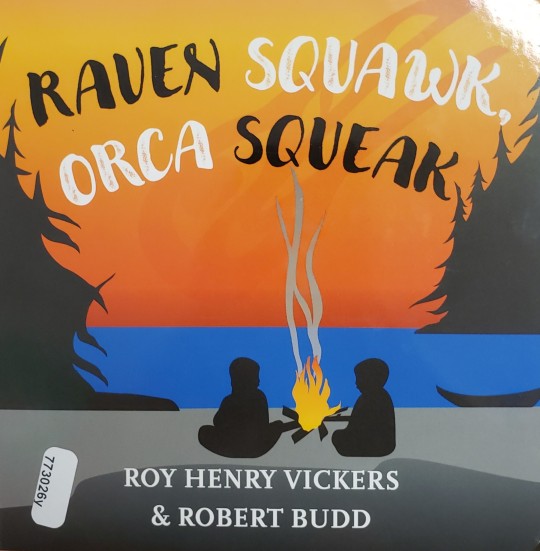
Raven Squawk, Orca Squeak (2020)
Story and Art: Roy Henry Vickers & Robert Budd
Canadian
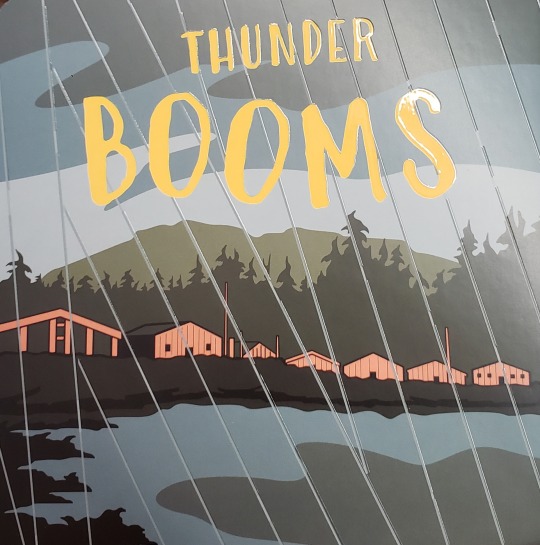








#first nations#indigenous#canadian#canlit#Roy Henry Vickers#Robert Budd#raven squawks orca squeaks#pnw#pacific northwest#board books#animals#hockey#long houses#sea lions#geese#canoes#bears#eagles#picture books#kid books#kidlit#children's books#2020s#20s
0 notes
Text

Canadian troops on the move somewhere on the Western Front. Note the truck on the side with Vickers machine guns at ready.
#history#historical photos#world war one#the first world war#world war 1#wwi#the great war#1917#canadian history#ww1#world war 1 stories
77 notes
·
View notes
Text

The Battle of Flers Courcelette 15 -22 September: Canadians testing a Vickers machine gun.
13 notes
·
View notes
Photo
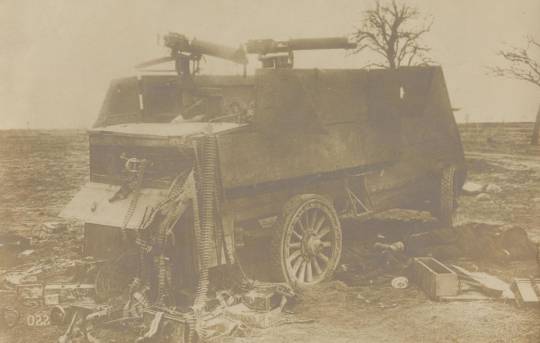
Canadian Armored Autocar of the Brutinel Brigade armed with a pair of Vickers machine guns knocked out during WWI
22 notes
·
View notes
Text

The twin-engined Hampden would serve with Bomber Command in the first years of the Second World War, taking part in the first raid on Berlin in August 1940 and in 'Operation Millennium' during May 1942. The Handley Page Hampden also served with Coastal Command, playing a part in the U-boat battle, before being phased out of service.
Handley Page Hampden
When the Air Ministry issued Specification B.9/32 during September 1932 which called for a twin-engined bomber Handley Page submitted their H.P.52 design which would compete against Vickers 271 design, which would go on to become the Vickers Wellington. The Handley Page H.P.52, very different in appearance to its rival featuring a long narrow fuselage, which earned it the nickname 'Flying Suitcase', would have a crew of four made up of pilot, navigator/bomb-aimer, wireless operator and gunner. The Handley Page H.P.52 prototype flew for the first time, nearly fours years later, when it took to the skies on the 21st June 1936 with Major James Cordes at the controls.
With a new specification of B.30/36 the 15th August 1936 saw an order for 180 Handley Page Hampden Mk Is with the 24th May 1938 seeing the first production example flying. The following month on the 24th June 1938 the Viscountess Hampden officially christened the type. At the same time of the original order for 180 aircraft another order for 100 aircraft, this time powered by the Napier Dagger engine, was placed under Specification B.44/36. Production of these would be handed over to Short Brothers and Harland and this aircraft would be renamed the Handley Page Hereford.
The Hampden Mk I was powered by a pair of 1,000-hp Bristol Pegasus XVIII engines which gave the aircraft a top speed of 254 mph, range of 1,885 miles with a service ceiling of 19,000 ft. Armament was six 0.303-in machine-guns with two firing forward and two each in the dorsal and ventral positions, bomb load was 4,000lb. The new aircraft was sent to the Aeroplane and Armament Experimental Establishment at Martlesham Heath for trials and this was followed by trials at the Central Flying School based at RAF Upavon.
The Royal Air Force began to receive their new aircraft and the first to receive the new type were No. 49 Squadron based at RAF Scampton, who at the time were using the Hawker Hind, on the 20th September 1938 and by the time the Second World War (1939 - 1945) broke out in September 1939 ten squadrons were using the Hampden and early reconnaissance operations were completed during the same month. However on the 29th September 1939 eleven Hampdens were undertaking reconnaissance duties over the Heligoland Bight area when five of the aircraft were shot down by enemy fighters and as a result the type was moved to night time operations. The aircraft would again be used in daylight raids during the Norwegian campaign but once again suffered heavy losses. Despite this early setback the Handley Page Hampden soon found its niche as a minelayer with a total of 1,209 sorties flown by the close of 1940.
Over the next two years the Hampden played a role in the Royal Air Forces bombing offensive, including taking part in the first raid on Berlin, Germany on the 25th August 1940. Although the aircraft was coming to the end of its front line service with Bomber Command in 1942, it would take part in 'Operation Millennium', the first 1,000 bomber raid by Bomber Command, on the 30th May 1942. This saw 1,047 aircraft of all types attack Cologne, Germany, with 41 aircraft lost and over 400 people killed. Its last Bomber Command operation on the 15th September 1942 saw No. 408 Squadron, Royal Canadian Air Force Hampdens take part in a raid on Wilhelmshaven, Germany. Shortly before this a number of Hampdens were sent to serve as protection for convoys in North Russia however this was beset with problems as of the thirty two aircraft, flying from the Shetlands on the 4th September 1942, sent only twenty three would arrive so instead the Russians were given the aircraft.
Serving with Coastal Command as a torpedo bomber, known as the Hampden TB Mk I, April 1942 saw Coastal Command begin to receive its first aircraft when No. 144 Squadron was transferred from Bomber Command, followed by No. 455 Squadron, Royal Australian Air Force on the 27th April 1942. During its time with Coastal Command the Hampden would be used for convoy escort and maritime reconnaissance. By 1943 the Handley Page Hampden was beginning to be removed from service and No. 455 Squadron, RAAF based at RAF Sumburgh were the last squadron to use the type for operations before they received Bristol Beaufighters.
By the time production of the Hampden stopped 1,432 of the type had been produced.
Technical Details
Click on the aircraft image to view a larger version.
Top Speed Range Service Ceiling Armament
Hampden Mk I 254 mph 1,885 miles 19,000 ft six 0.303-in machine-guns
4,000lb bombs
3 notes
·
View notes
Photo
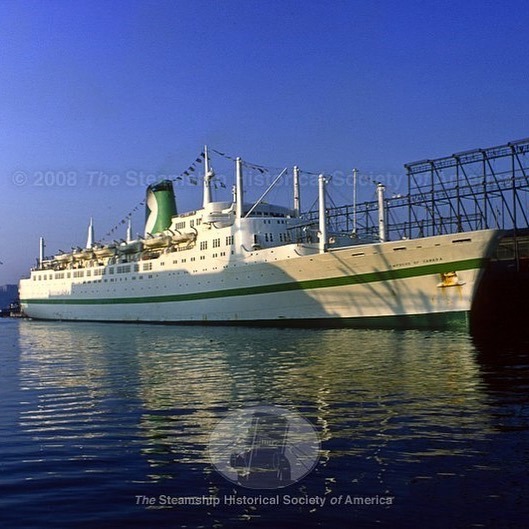
On December 12, 1970, this picture of Canadian Pacific's Empress Of Canada b) Mardi Gras was taken at New York in her later Canadian Pacific Steamships colors. She was built by Vickers-Armstrongs at Newcastle-on-Tyne in 1961. Braun Brothers Collection, SSHSA Archives. See more from this collection at bit.ly/BraunBrothersCollection. #OnThisDay #shiphistory (at The Steamship Historical Society of America) https://www.instagram.com/p/CmE4dgosvKB/?igshid=NGJjMDIxMWI=
8 notes
·
View notes
Link
0 notes
Text

"Au procès de David Côté," La Patrie. August 4, 1943. Page 4.
----
Le procès de David Coté, accusé d'avoir incité les ouvriers de Canadian Vickers à faire la grève et à rester en grève, est commencé ce matin devant le juge Armani Cloutier. Une longue argumentation eut lieu entre Me Gérald Fauteux, représentant le ministère public, et Me Guy Merrill-Desaulniers, représentant de la défense, sur la validité des accusations portées contre l'inculpé.
Me Desaulniers demande au tribunal le renvoi immédiat des deux plaintes déclarant qu'il était illegal de faire subir un procès sur deux chefs d'accusation à la fois.Le juge Cloutier rejeta les objections de Me Desaulniers.
Au moment où nous allons sous presse Me Fauteax interroge M. Len Stewart, 2668, Saint-Zotique. Ce procès durera tout l'après-midi.
#montreal#recorder's court#united shipyards#canadian vickers#political prisoner#union organizing#agitator#working class politics#suppression of dissent#working class struggle#illegal strike#strike#war workers#canada during world war 2#crime and punishment in canada#history of crime and punishment in canada
0 notes
Text
Events 11.10 (after 1950)
1951 – With the rollout of the North American Numbering Plan, direct-dial coast-to-coast telephone service begins in the United States.
1954 – U.S. President Dwight D. Eisenhower dedicates the USMC War Memorial (Iwo Jima memorial) in Arlington Ridge Park in Arlington County, Virginia.
1958 – The Hope Diamond is donated to the Smithsonian Institution by New York diamond merchant Harry Winston.
1969 – National Educational Television (the predecessor to the Public Broadcasting Service) in the United States debuts Sesame Street.
1970 – Vietnam War: Vietnamization: For the first time in five years, an entire week ends with no reports of American combat fatalities in Southeast Asia.
1970 – Luna 17: uncrewed space mission launched by the Soviet Union.
1971 – In Cambodia, Khmer Rouge forces attack the city of Phnom Penh and its airport, killing 44, wounding at least 30 and damaging nine aircraft.
1971 – A Merpati Nusantara Airlines Vickers Viscount crashes into the Indian Ocean near Padang, West Sumatra, Indonesia, killing all 69 people on board.
1972 – Southern Airways Flight 49 from Birmingham, Alabama is hijacked and, at one point, is threatened with crashing into the nuclear installation at the Oak Ridge National Laboratory. After two days, the plane lands in Havana, Cuba, where the hijackers are jailed by Fidel Castro.
1975 – The 729-foot-long freighter SS Edmund Fitzgerald sinks during a storm on Lake Superior, killing all 29 crew on board.
1975 – Israeli-Palestinian conflict: the United Nations General Assembly passes Resolution 3379, determining that Zionism is a form of racism.
1979 – A 106-car Canadian Pacific freight train carrying explosive and poisonous chemicals from Windsor, Ontario, Canada derails in Mississauga, Ontario.
1983 – Bill Gates introduces Windows 1.0.
1985 – A Dassault Falcon 50 and a Piper PA-28 Cherokee collide in mid-air over Fairview, New Jersey, killing six people and injuring eight.
1989 – Longtime Bulgarian leader Todor Zhivkov is removed from office and replaced by Petar Mladenov.
1989 – Germans begin to tear down the Berlin Wall.
1995 – In Nigeria, playwright and environmental activist Ken Saro-Wiwa, along with eight others from the Movement for the Survival of the Ogoni People (Mosop), are hanged by government forces.
1997 – WorldCom and MCI Communications announce a $37 billion merger (the largest merger in US history at the time).
2002 – Veteran's Day Weekend Tornado Outbreak: A tornado outbreak stretching from Northern Ohio to the Gulf Coast, one of the largest outbreaks recorded in November.
2006 – Sri Lankan Tamil politician Nadarajah Raviraj is assassinated in Colombo.
2006 – The National Museum of the Marine Corps in Quantico, Virginia is opened and dedicated by U.S. President George W. Bush, who announces that Marine Corporal Jason Dunham will posthumously receive the Medal of Honor.
2008 – Over five months after landing on Mars, NASA declares the Phoenix mission concluded after communications with the lander were lost.
2009 – Ships of the South and North Korean navies skirmish off Daecheong Island in the Yellow Sea.
2019 – President of Bolivia Evo Morales and several of his government resign after 19 days of civil protests and a recommendation from the military.
2020 – Armenia and Azerbaijan sign a ceasefire agreement, ending the Second Nagorno-Karabakh War, and prompting protests in Armenia.
0 notes
Text
Canada's Resilience: Honoring National War Memorial

The Significance of the National War Memorial
On the somber ninth anniversary of the attack at the National War Memorial and on Parliament Hill, Prime Minister Justin Trudeau issued a poignant statement, remembering the fallen and emphasizing the unity of the nation. This attack, which occurred on October 22, 2014, left one dead and several injured, leaving an indelible mark on Canada and its people.
Honoring the Brave
Trudeau paid tribute to Corporal Nathan Cirillo, a sentinel guarding the Tomb of the Unknown Soldier. He also honored Warrant Officer Patrice Vincent, who lost his life two days prior in a separate attack in Saint-Jean-sur-Richelieu, Quebec. These two brave members of the Canadian Armed Forces had unwavering dedication to their country. On this day, Canadians remember them with the deepest condolences to their families, loved ones, and colleagues.
Saluting First Responders and Heroes
The Prime Minister also extended gratitude to the first responders who risked their lives to mitigate the attacks and keep Canadians safe. Furthermore, he praised the bystanders who acted selflessly in the face of danger to aid the victims. Their courage and swift action exemplified the resilience and unity that define Canada in the face of adversity.
Timeline: Events Leading up to the Attack
October 22, 2014 - The Day That Shook Canada
Nine years ago, on October 22, 2014, Canada was confronted with a tragedy that sent shockwaves across the nation. A meticulously planned act of terrorism unfolded, catching the country by surprise. The perpetrator, Michael Zehaf-Bibeau, already known to Canadian authorities due to his history of criminal activity, orchestrated the attack that would change Canada forever.
The Attack: Details of the Incident
An Act of Terror on Sacred Ground
On that fateful morning, Zehaf-Bibeau approached the National War Memorial, armed with a lever-action rifle. The assailant shot Corporal Nathan Cirillo, who was guarding the monument, tragically losing his life in service to his country. Zehaf-Bibeau then carjacked a vehicle and rapidly advanced towards Parliament Hill, breaching security and gaining entry to the Centre Block, the heart of Canada's government.
Inside Parliament, a brief firefight unfolded between the assailant and security personnel, ultimately culminating in Sergeant-at-Arms Kevin Vickers stopping Zehaf-Bibeau. Although the attack had a limited scope, it exposed vulnerabilities in Canada's security infrastructure, leading to a comprehensive review of the nation's readiness to confront such threats.
Response and Aftermath: Canada's Reaction and Consequences
Unity in the Face of Adversity
Canada's response to the attack was characterized by unity and resilience. This tragic incident served as a stark reminder that no nation is entirely immune to acts of terrorism, regardless of its reputation for peace and security. The nation united in mourning the loss of Corporal Nathan Cirillo and celebrated the bravery of those who confronted the assailant.
Countering Radicalization
The attack prompted a nationwide conversation about the factors contributing to the radicalization of individuals like Zehaf-Bibeau. Consequently, the government pledged to address these root causes and work diligently towards preventing radicalization, with the aim of building a more inclusive and tolerant society.
Enhanced Security Measures
Afterward, authorities implemented a series of security measures to safeguard Canadian institutions and its citizens. They increased funding for counter-terrorism efforts, which improved intelligence-sharing among security agencies and bolstered border security. New legislation enhanced the powers of law enforcement agencies in monitoring and countering potential threats.
Security agencies also collaborated with communities to identify individuals at risk of radicalization and provide support to divert them from extremism. Public awareness campaigns were launched to educate Canadians about the signs of radicalization and how to report suspicious activities.
The attack on the National War Memorial and Parliament Hill was a tragic event that prompted Canada to reflect on its security posture and adapt to an evolving threat landscape. It demonstrated the nation's resilience and unity in the face of adversity. Canada's response, with its focus on both security and the prevention of radicalization, serves as an example of a nation determined to maintain its commitment to peace and security while safeguarding its citizens from the threat of terrorism.
Sources: THX News, Wikipedia & The Canadian Government.
Read the full article
#Canada'sresilienceinadversity#CanadianArmedForcestribute#MichaelZehaf-Bibeauincident#NationalWarMemorialCanada#Ottawaattackanniversary#ParliamentHillsecurityreview#PreventingradicalizationinCanada#Rememberingfallensoldierstoday#Securitymeasuresafterattack#Sergeant-at-ArmsKevinVickers
0 notes
Text

One Eagle Soaring (2018)
Story and Art: Roy Henry Vickers & Robert Budd
Canadian
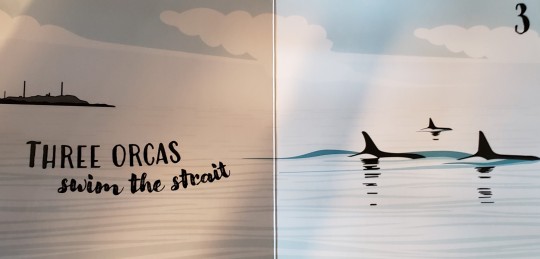
#one eagle soaring#2010s#10s#board books#kid books#picture books#children's books#kidlit#children's literature#orcas#eagles#roy henry vickers#robert budd#canlit#award winning#number books
3 notes
·
View notes
Photo


The Medals of Kevin Vickers ONB, SC,
Mr Vickers is a politician, retired diplomat and RCMP officer from Chatham New Brunswick. He was serving as Sergeant at Arms to the Canadian Parliament in 2014 when Zehaf-Bibeau went on a shooting rampage. Vickers returned fire, fatal wounding the gunman, and for his actions was awarded the Canadian Star of Courage SC.He also holds;
the Order of New Brunswick,
the 125th Anniversary of the Canadian federation Medal 1992
the 2002 Golden Jubilee Medal (Canada issue)
the 2012 diamond Jubilee Medal (Canada issue)
& the RCMP Long Service Medal & clasp
1 note
·
View note